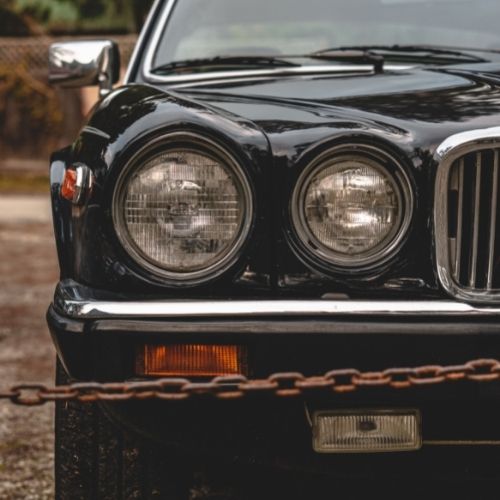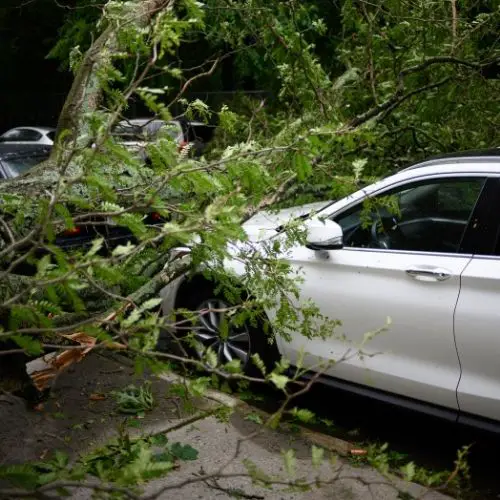We may get commissions for purchases made through links in this post. Thanks for the support! 👍
So, the headlights on your vehicle are fogged up with moisture. Modern headlight housings are not sealed airtight, resulting in this annoying yet widespread occurrence. Vehicle headlight designers have struggled with this problem for years, how to prevent condensation completely.
However, as it is now, the condensation in your headlights will most often go away on its own. Below we will explore other aspects of headlight condensation as well as occurrences in which the situation does not resolve itself.
What is headlight condensation?

Your headlights will become moist on the inside of the headlight when the air outside the lens is at a lower temperature than the air inside the lens, and when there is some form of moisture being allowed inside of the assembly.
Condensation may happen when you park your vehicle for the evening, and it is warm from being driven. The night air will make its way through the vents to mix with the warmer air resulting in the cloudy lens that you see first thing in the morning.
Headlight condensation will affect the quality of light emitted, and there’s the added risk of the assembly rusting over time. The way moisture comes through the fender or the vents from the top and into one particular headlight vent will sometimes cause one headlight to have the problem of condensation.
The headlights on a car will usually clear up on their own once the car begins to warm up in the sunshine. With the advent of LED headlights in the luxury vehicle models, simply turning on the headlights or waiting for the sunlight to chip in will not take care of the condensation issue.
You see, LED headlights do not get warm in the same way that halogen headlights do and, as such, will require more direct effort to fix condensation concerns. Ninety-five percent of vehicles still use halogen headlight bulbs. Therefore, it is safe to say warming up the car or turning on the headlights for a while will take care of this problem.
What if the condensation doesn’t go away on its own?
So the moisture isn’t going away eh? Well, this is likely due to a bigger problem that just a little bit of water getting in, and likely means there is a large build up of water inside of the assembly. This also generally means that your assembly is likely damaged in some way.
Strangely enough, if you run into this you can find the crack by removing the assembly from the car, remove all electrical components (including the bulb) and filling it up with water. Wherever water is leaking from (at least from places where there aren’t intended holes) you will find where the damage is. Then you can use a plastic welder like this one to fix that hole or crack!
From there, you can use a blow dryer to get rid of any left over water after you dump it out, and reinstall! Now this issue shouldn’t be a problem anymore.
Alternatively, you can also just completely replace the assembly by buying one here.
General causes of headlight condensation
- Cracks in the body of the headlight assembly plastic
- Just nature, with cold air on the outside and warm air on the inside of the lens
- Poor vent quality on your headlights
- Blocked headlight vents. Debris from leaves, insects, and spider webs are regular offenders
- Where you park is also a factor; underground or damp and shady areas are known culprits.
When to get professional help

While occasional condensation is acceptable, if your headlights never seem to dry, then you may have a problem.
Suppose you are not a self-assured DIY mechanic who wishes to fix the problem in your home garage or driveway. In that case, I will ask that you employ the service of your vehicle dealer or professional mechanic. A crack in the lens or housing and improperly fitted rubber gaskets are some of the reasons you may not be able to fix your headlight condensation on your own.
Premature bulb failure and electrical short circuits in some vehicle models are terrible news resulting from constant headlight condensation.
Your vehicle dealer or mechanic should be able to help you identify the source of the problem and have it sorted.
- 4 reasons why Headlight Washers are useful (and used on high end cars)
- Headlights Yellowing or Foggy? Here are a couple reasons why
- 5 Reasons your Headlights are dimmer than they should be
What other things should you do to take care of your headlights?
- You may try the various protectants that are available to prevent fogging of your headlights.
- Wash and clean the outer surfaces of the headlight with a glass cleaner containing ammonia. Apply good quality car wax to bring back shine to the headlight.
- A headlight restoration kit may also be an option. It is made from chemicals that will remove any dirt on the headlights.
- Use a plastic protectant on your headlight. It will prevent ultra violet (UV) damage and rusting. The plastic protectant also acts as a barrier between the headlight and debris from the roadway.
- You will need to reapply the car wax, plastic protectant or restoration products on a regular basis. You will definitely want to ensure stay clear and bright.
You car has many features that need care and attention, your headlights are definitely some of those. Having condensation build up in them are both risky and unpleasant to see. However so, these are car issues you do not have to live with. You now know that in most cases headlight condensation will go away on its own, however, there will be cases where this doe not happen. Though headlight condensation may be an easy fix, in situations where it persist be sure to acquire the help of a professional.
![This Is How Cars Have Wifi [And Why]](https://amanandhisgear.com/wp-content/uploads/2020/01/How-do-cars-have-wifi.jpg)

